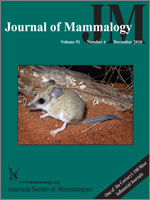The collared peccary (Pecari tajacu) is a social species that recently has expanded its historical range, yet little is known of its dispersal behavior at the population or biogeographic level. We used autosomal and cytoplasmic markers to assess whether the genetic variation among 4 populations in Texas retains a signal of historically recent founding events. Genetic differentiation based on mitochondrial DNA (mtDNA) haplotype frequencies (FST) among these 4 populations was substantial. The mtDNA haplotype mismatch distributions indicate that P. tajacu recently has expanded its range across Texas; however, microsatellite-based standard analyses of molecular variance (AMOVAs) and pairwise FST estimates indicated little variation among populations, suggesting that dispersal is accomplished primarily by males. We also tested the alternative power of mtDNA haplotype or microsatellite genotype distribution patterns to detect a sex bias in instantaneous short-distance dispersal. Sex-specific hierarchical AMOVAs of mtDNA haplotype distributions (based on data from the most genetically diverse population) yielded significantly larger female-specific fixation index values compared to males, indicating a male instantaneous dispersal bias; however, variation in microsatellite frequency distribution was not partitioned in a sex-specific manner. Also, when sex-specific pairwise FST/(1 − FST) among herds was regressed against the log of the distance between each pair of herds, we found no significant effect of distance for either sex and no sex-specific difference using other microsatellite-based analyses (mean sex-specific relatedness, r, or FST). We conclude that sampling scale limits microsatellite-based methods of detecting instantaneous dispersal sex bias, especially when gene flow is substantial and microsatellite polymorphism is modest (<20 alleles/locus). These results indicate that mtDNA can be used to infer instantaneous dispersal behavior for both sexes in cases where microsatellites have proven insufficient.
How to translate text using browser tools
16 December 2010
Measuring sex-biased dispersal in social mammals: comparisons of nuclear and mitochondrial genes in collared peccaries
J. D. Cooper,
P. M. Waser,
D. Gopurenko,
E. C. Hellgren,
T. M. Gabor,
J. A. DeWoody
ACCESS THE FULL ARTICLE

Journal of Mammalogy
Vol. 91 • No. 6
December 2010
Vol. 91 • No. 6
December 2010
analysis of molecular variance (AMOVA)
isolation by distance
microsatellites
mitochondrial DNA (mtDNA)
population genetics
sex-biased dispersal
social organization




